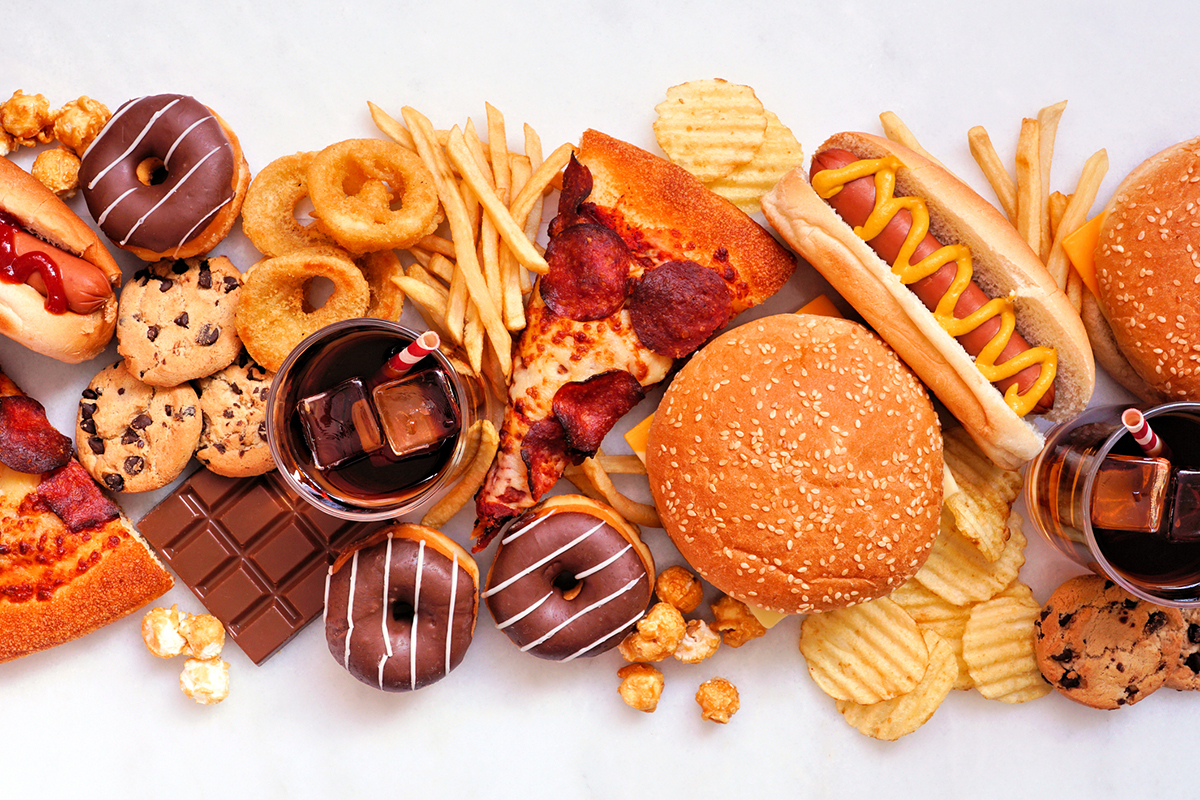The Dietary Guidelines for Americans—the DGAs—are due for an update to set goals for 2025-2030. Under consideration were measures aimed at calling for reductions in intake of UPFs—ultra-processed foods.
The nutrition experts tasked with crafting the guidelines—the Dietary Guidelines Advisory Committee—consisting of 20 academics, rendered their verdict last month: They failed the American public.
“If you were hoping to see where ultra-processed foods might fit in the next Dietary Guidelines for Americans, hold that thought,” reports STATnews. “Scientific experts tasked with advising federal officials drafting the 2025-2030 Dietary Guidelines for Americans said the data were far too limited to draw conclusions.”
What’s the hold up?! We know UPFs are bad for us. But the “experts” can’t decide. Sounds like a classic case of “analysis paralysis”.
Ultra-processed foods now comprise 2/3 of calories in children and teen diets.
It’s been established that UPF consumption is connected to 32 negative health outcomes:
“Greater exposure to ultra-processed food was associated with a higher risk of adverse health outcomes, especially cardiometabolic, common mental disorder, and mortality outcomes.”
The BMJ concludes:
“In the last decades, obesity, type 2 diabetes and related diseases have become global epidemics, leading the health systems of many countries to or beyond breaking point . . . Taken together, the totality of evidence summarised here shows beyond reasonable doubt that increased consumption of ultra-processed foods is a major contributor to the pandemic of obesity, type 2 diabetes and related diseases.”
The latest disclosures are links to inflammatory bowel disease and to accelerated aging.
What are UPFs? I provided a definition in a recent newsletter article (“Ultra-processed foods—What they are and why are they so bad”):
“Ingredients characteristic of UPFs include food substances of no or rare culinary use, including sugar, protein and oil derivatives (e.g., high-fructose corn syrup, maltodextrin, protein isolates, hydrogenated oil) and cosmetic additives (e.g., colours, flavours, flavour enhancers, emulsifiers, thickeners, and artificial sweeteners) designed to make the final product more palatable.” (Source)
That means a high percentage of foods found in supermarket aisles contribute to our UPF burden. I once asked a friend of mine who is a retired COO of a big supermarket chain why his stores didn’t have a dedicated section for health food. He said:
“If we were to call it ‘health food’, what does it say about the rest of the food in the store?”
How to avoid ultra-processed foods? Just prepare meals from fresh, dry or frozen fruits or vegetables, grains, legumes, meat, fish and milk.
Of interest is that the BMJ researchers concluded that virtually all “industrially-produced” breads were delivery systems for harmful added ingredients like refined oils, sugar, artificial flavorings, colorings and preservatives.
So, too, were “energy bars” and breakfast cereals, commercial salad dressings, sauces, and condiments.
Not to mention the obvious ones like southern fried chicken and fish sticks, French fries, chips, luncheon meats, instant noodles, candy, cookies, fruit drinks, sports drinks, and soda (including those artificially sweetened). Frozen and “convenience meals” are also rife with harmful additives. And those new faux meat products? All are ultra-processed, with sketchy ingredients.
Powerful forces conspire to muddy the waters about UPFs. Well-funded coalitions of big food and beverage conglomerates push obfuscations by experts-for-hire. They argue that the definitions of UPFs are imprecise and “controversial”; that many “healthful” food options are actually highly-processed; that limiting choices is fundamentally anti-American; and that poor people rely on cheap, readily-available ultra-processed meals to meet their nutritional needs.
What’s more, paid influencers are running interference for makers of futuristic meat alternatives designed to “save the planet”. Big food hopes to reap a bonanza appealing to conscientious Americans’ desire to reduce their carbon footprints. To mimic meat, they invoke a Frankenstein mix of chemicalized ingredients.
It’s not a mere conspiracy theory to suggest that members of the U.S. dietary guidelines advisory committee are swayed by financial ties to Big Food, Big Pharma and agribusiness. In a scathing reviewresearchers uncovered unsavory conflicts of interest (COIs) among the 2020 committee members:
“Our analysis found that 95% of the committee members had COI with the food and/or pharmaceutical industries and that particular actors, including Kellogg, Abbott, Kraft, Mead Johnson, General Mills, Dannon and the International Life Sciences, had connections with multiple members. Research funding and membership of an advisory/executive board jointly accounted for more than 60% of the total number of COI documented . . . Trustworthy dietary guidelines result from a transparent, objective and science-based, process. Our analysis has shown that the significant and widespread COI on the committee prevent the DGA from achieving the recommended standard for transparency without mechanisms in place to make this information publicly available.”
We lag behind the rest of the world’s countries that have taken a pro-active approach to regulating UPFs. A 2024 article in the Guardianheralds: “Latin America labels ultra-processed foods. Will the U.S. follow?”. In 2016 Chile introduced warning labels on products laden with salt and sugar . . .
“Additionally, the country banned the sale and promotion of products with warning labels in schools, restricted marketing of those products to children, and eventually fully banned companies from marketing foods with warning labels.”
Was the campaign effective?
“A 2021 study found that Chilean families purchased 27% less sugar and 37% less salt from foods labeled with ‘high in’ warnings in December 2017, after the implementation of the label, than they would have if the labeling and advertising law had not been implemented.”
Now Peru, Uruguay, Mexico, Argentina and Colombia all mandate warning labels.
The UK is enacting a ban on TV advertising of junk food before 9:00 PM, to begin in 2025, in an effort to stave off childhood obesity: “Health minister Andrew Gwynne said the restrictions will ‘help protect children’ from advertising that evidence shows can influence their eating preferences from a young age.”
In the U.S., the percentage of children and adolescents who are overweight or obese has more than tripled since the 1970s: In 2017–2018, 19.3% of children and adolescents ages 2–19 were obese, with 6.1% having severe obesity.
“Under the new rules a particular food will be banned if it meets two criteria. Firstly, if it is classified as ‘less healthy’ on a government scoring system after its nutrients have been analysed – this includes salt, fat, sugar and protein.
Secondly, if it falls into one of 13 categories created by the government. They include:
- Soft drinks: This covers any product that contains added sugar such as cola, lemonade and squash. It also includes fruit juice, smoothies and energy drinks.
- Savoury snacks: Crisps mainly, but this also extends to crackers, rice cakes, tortilla chips and Bombay mix. There are exemptions for flavoured nuts, dried fruit and jerky.
- Breakfast cereal: This includes granola, muesli, porridge oats and other items you would find in the breakfast aisle of a supermarket.
- Chocolates and sweets: This applies to the vast majority of items you would find listed under confectionery, but also includes popcorn and chewing gum.
- Ice cream: Dairy and non-dairy products, such as ice lollies, are covered by this as well as frozen yoghurt, sorbet and gelato.
- Cakes and cupcakes: Flapjacks, doughnuts and éclairs are also included in this category – but icing is exempted.
- Biscuits and bars: Protein and cereal bars are included, as are other products like wafers and toaster pastries.
- Morning goods: Croissants, pain au chocolat and other pastries are the main foods covered here – but this category also extends to crumpets, scones, fruit loaves and hot cross buns.
- Desserts and puddings: Custard, jelly and mousses are included, but there are exemptions for tinned fruit, cream and syrups.
- Yoghurt: Any variety that has been sweetened is covered by this category, as are non-dairy alternatives, probiotic yoghurt and drinkable varieties.
- Pizza: Plain bases and garlic bread are exempted from this, but otherwise all sizes and types of pizza are included.
- Potatoes: Plain and sweet varieties that have not been cut or cooked are exempt, but several other potato-based products are included such as chips, hash browns and croquettes.
- Ready meals: A broad category that covers anything intended to be eaten as a main meal, often after being reheated, and requires no further preparation. It also includes sandwiches and burgers.”
How’s that for a ready-made template worth emulating?
A plethora of products and ingredients currently available in the U.S. are banned in many EU countries and across the world:
“Surprisingly, the list is pretty long, and it includes products that are pretty popular in U.S. households. RITZ Crackers, Gatorade, Wheat Thins, Frosted Flakes and Coffee-mate creamer are just some of the items banned in other countries because of some ingredients they contain . . . Skittles, Pop-Tarts, Gatorade and those yummy Little Debbie’s products are banned in the European Union because contain dyes like yellow 5, yellow 6 and red 40. The EU banned these artificial colors after their scientific research indicated they could be harmful to health, especially to young children.”
Stateside we need to cut through the babble and take a common sense approach to UPFs. As Supreme Court Justice Potter once famously answered when asked: “What’s your definition of obscenity?” He replied simply, “I know it when I see it.”
We should treat junk food the same way.







